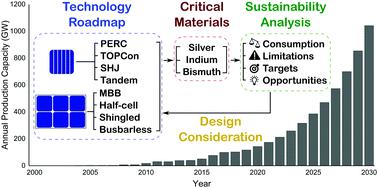当前位置:
X-MOL 学术
›
Energy Environ. Sci.
›
论文详情
Our official English website, www.x-mol.net, welcomes your
feedback! (Note: you will need to create a separate account there.)
Design considerations for multi-terawatt scale manufacturing of existing and future photovoltaic technologies: challenges and opportunities related to silver, indium and bismuth consumption
Energy & Environmental Science ( IF 32.4 ) Pub Date : 2021-09-27 , DOI: 10.1039/d1ee01814k Yuchao Zhang 1 , Moonyong Kim 1 , Li Wang 1 , Pierre Verlinden 1, 2, 3, 4 , Brett Hallam 1
Energy & Environmental Science ( IF 32.4 ) Pub Date : 2021-09-27 , DOI: 10.1039/d1ee01814k Yuchao Zhang 1 , Moonyong Kim 1 , Li Wang 1 , Pierre Verlinden 1, 2, 3, 4 , Brett Hallam 1
Affiliation

|
To significantly impact climate change, the annual photovoltaic (PV) module production rate must dramatically increase from ∼135 gigawatts (GW) in 2020 to ∼3 terawatts (TW) around 2030. A key knowledge gap is the sustainable manufacturing capacity of existing and future commercial PV cell technologies imposed by scarce metals, and a suitable pathway towards sustainable manufacturing at the multi-TW scale. Assuming an upper material consumption limit as 20% of 2019 global supply, we show that the present industrial implementations of passivated emitter and rear cell (PERC), tunnel oxide passivated contact (TOPCon), and silicon heterojunction (SHJ) cells have sustainable manufacturing capacities of 377 GW (silver-limited), 227 GW (silver-limited) GW and 37 GW (indium-limited), respectively. We propose material consumption targets of 2 mg W−1, 0.38 mg W−1, and 1.8 mg W−1 for silver, indium, and bismuth, respectively, indicating significant material consumption reductions are required to meet the target production rate for sustainable multi-TW scale manufacturing in about ten years from now. The industry needs urgent innovation on screen printing technologies for PERC, TOPCon, and SHJ solar cells to reduce silver consumption beyond expectation in the Industrial Technology Roadmap for PV (ITPRV), or the widespread adoption of existing and proven copper plating technologies. Indium cannot be used in any significant manufacturing capacity for PV production, even for futuristic 30%-efficient tandem devices. The current implementation of low-temperature interconnection schemes using bismuth-based solders will be limited to 330 GW of production. With half the silver-limited sustainable manufacturing capacity as PERC, the limited efficiency gains of SHJ and TOPCon cell technologies do not justify a transition away from industrial PERC, or the introduction of indium- and bismuth limitations for SHJ solar cells. On the other hand, futuristic two-terminal tandems with efficiency potentials over 30% have a unique opportunity to reduce material consumption through substantially reduced series resistance losses.
中文翻译:

现有和未来光伏技术的多太瓦级制造的设计考虑:与银、铟和铋消耗相关的挑战和机遇
为了显着影响气候变化,光伏 (PV) 组件的年生产率必须从 2020 年的~135 吉瓦 (GW) 大幅增加到 2030 年的~3 太瓦 (TW)。一个关键的知识差距是现有和未来的可持续制造能力稀有金属强加的商业光伏电池技术,以及实现多 TW 规模可持续制造的合适途径。假设材料消耗上限为 2019 年全球供应量的 20%,我们表明目前钝化发射极和背面电池 (PERC)、隧道氧化物钝化接触 (TOPCon) 和硅异质结 (SHJ) 电池的工业实施具有可持续的制造能力分别为 377 吉瓦(白银限制)、227 吉瓦(白银限制)和 37 吉瓦(铟限制)。我们提出 2 mg W 的材料消耗目标-1、0.38 毫克 W -1和 1.8 毫克 W -1分别为银、铟和铋,这表明需要显着减少材料消耗,才能在大约十年后达到可持续多 TW 规模制造的目标生产率。行业迫切需要对 PERC、TOPCon 和 SHJ 太阳能电池的丝网印刷技术进行创新,以减少光伏工业技术路线图 (ITPRV) 中超出预期的银消耗量,或广泛采用现有和经过验证的镀铜技术。铟不能用于光伏生产的任何重要制造能力,即使是未来效率为 30% 的串联设备也是如此。目前使用铋基焊料的低温互连方案的产量将限制在 330 GW。白银有限的可持续制造能力是 PERC 的一半,SHJ 和 TOPCon 电池技术的有限效率增益并不能证明从工业 PERC 过渡或为 SHJ 太阳能电池引入铟和铋限制是合理的。另一方面,具有超过 30% 效率潜力的未来主义两端串联具有独特的机会,可以通过显着降低串联电阻损耗来减少材料消耗。
更新日期:2021-09-30
中文翻译:

现有和未来光伏技术的多太瓦级制造的设计考虑:与银、铟和铋消耗相关的挑战和机遇
为了显着影响气候变化,光伏 (PV) 组件的年生产率必须从 2020 年的~135 吉瓦 (GW) 大幅增加到 2030 年的~3 太瓦 (TW)。一个关键的知识差距是现有和未来的可持续制造能力稀有金属强加的商业光伏电池技术,以及实现多 TW 规模可持续制造的合适途径。假设材料消耗上限为 2019 年全球供应量的 20%,我们表明目前钝化发射极和背面电池 (PERC)、隧道氧化物钝化接触 (TOPCon) 和硅异质结 (SHJ) 电池的工业实施具有可持续的制造能力分别为 377 吉瓦(白银限制)、227 吉瓦(白银限制)和 37 吉瓦(铟限制)。我们提出 2 mg W 的材料消耗目标-1、0.38 毫克 W -1和 1.8 毫克 W -1分别为银、铟和铋,这表明需要显着减少材料消耗,才能在大约十年后达到可持续多 TW 规模制造的目标生产率。行业迫切需要对 PERC、TOPCon 和 SHJ 太阳能电池的丝网印刷技术进行创新,以减少光伏工业技术路线图 (ITPRV) 中超出预期的银消耗量,或广泛采用现有和经过验证的镀铜技术。铟不能用于光伏生产的任何重要制造能力,即使是未来效率为 30% 的串联设备也是如此。目前使用铋基焊料的低温互连方案的产量将限制在 330 GW。白银有限的可持续制造能力是 PERC 的一半,SHJ 和 TOPCon 电池技术的有限效率增益并不能证明从工业 PERC 过渡或为 SHJ 太阳能电池引入铟和铋限制是合理的。另一方面,具有超过 30% 效率潜力的未来主义两端串联具有独特的机会,可以通过显着降低串联电阻损耗来减少材料消耗。









































 京公网安备 11010802027423号
京公网安备 11010802027423号